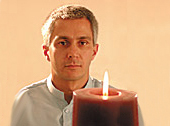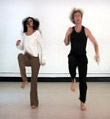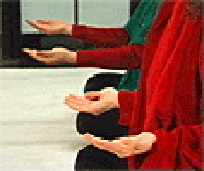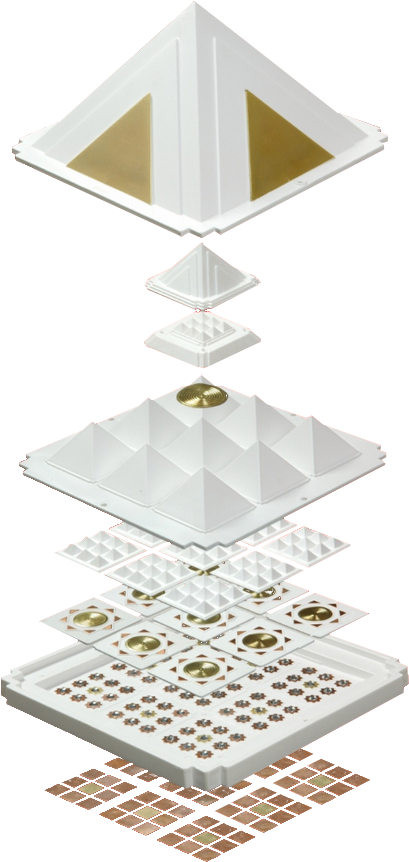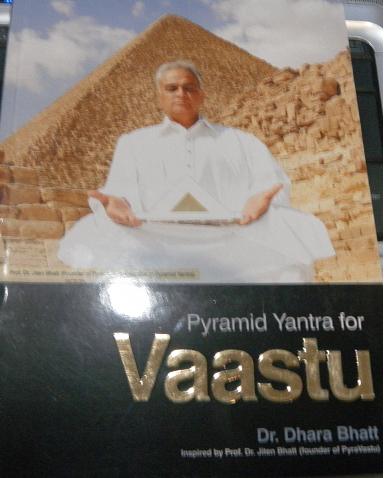Swami’s understanding about meditation comes from Osho, an enlightened spiritual leader from India.
There are many different, even contradictory ideas, about meditation. Osho’s approach is the need for the meditator to understand the nature of the mind, rather than fight with it.
Most of us most of the time are run by, dominated by, our thoughts or feelings. It follows that we tend to think we are those thoughts and feeling. Meditation is the state of simply being, just pure experiencing, with no interference from the body or mind. It’s a natural state but one that many of us have forgotten how to access.
The word meditation is also used for what is, more accurately, a meditation method. Meditative methods, techniques or devices are the means by which to create an inner ambiance that facilitates disconnecting from the body-mind so one can simply be. While initially it is helpful to put time aside to practice a structured meditation method, there are many techniques that are practiced within the context of one’s everyday life – at work, at leisure, alone, and with others.
Methods are needed only until the state of meditation – of relaxed awareness, of consciousness and centering – has become not just a passing experience but as intrinsic to one as, say, breathing.
Here are some common misconceptions about meditation:
Meditation is …..
1. Only for people who are on a spiritual search.
The benefits of meditation are manifold. Chief among them are the ability to relax and to be aware without effort. These are useful skills for just about everyone!
2. A practice to gain “peace of mind”.
Peace of mind is a contradiction in terms! By its very nature, the mind is a chronic commentator. What you can discover through meditation is the knack of finding the distance between yourself and the commentary, so that the mind, with its constant circus of thoughts and emotions, no longer intrudes on your inherent state of silence.
3. A mental discipline or effort to control or “tame” the mind, to become more mindful.
Meditation is neither a mental effort nor an attempt to control the mind. Effort and control involve tension, and tension is antithetical to the state of meditation. Besides, there is no need to control the mind, only to understand it and how it works. The meditator does not need to tame his mind, to become more mindful, but to grow more in consciousness.
4. Focusing, concentrating or contemplating.
Focusing, like concentrating, is a narrowing of awareness. You concentrate on one object to the exclusion of everything else. By contrast, meditation is all-inclusive, your consciousness is expanded. The contemplator is focused on an object – perhaps a religious object, a photograph or on an inspiring aphorism. The meditator is simply aware, but not of anything in particular.
5. A new experience.
Not necessarily. Sportsmen know this space, which they refer to as “the zone”. Artists know it – through singing, painting, playing music. We can know it through gardening, playing with the kids, walking on the beach, or making love. Even as children, we may have had experiences of it. Meditation is a natural state and one that you have almost certainly tasted, although perhaps without knowing the name of the flavor.
{mospagebreak title=WhyMeditate}
Why meditate?
The roots are in existence, making you a more integrated human being, an individual. The wings are in the fragrance that is released by being in contact with existence. The fragrance consists of freedom, love, compassion, authenticity, sincerity, a sense of humor, and a tremendous feeling of blissfulness.
The roots make you an individual, and the wings give you the freedom to love, to be creative, to share unconditionally the joy that you have found. The roots and wings come together. They are two sides of one experience, and that experience is finding the center of your being.
We are continuously moving on the circumference, always somewhere else far away from our own being, always directed toward others. When all this is dropped, when all objects are dropped, when you close your eyes to all that is not you, even your mind, your heartbeats are left far behind, and only a silence remains.
In this silence you will settle slowly into the center of your being, and then the roots will grow on their own accord, and the wings, too. You need not worry about them. You cannot do anything about them. They come on their own.
You simply fulfill one condition, and that is, to be at home, and the whole existence becomes a bliss to you, a benediction.
The inner revolution brings freedom and the only way to make oneself go through the inner revolution is meditation. Meditation simply means learning to forget all that you have learned. It is a process of deconditioning, a process of dehypnosis.
The society has burdened everybody with thousands of thoughts. Meditation simply helps you to come out of that world of thoughts, into a state of silence. It is a process of cleaning your slate completely, it is emptying all that has been forced and stuffed inside you.
Once you are empty, spacious, silent, clean, the revolution has happened, the sun has risen. Then you live in its light! And to live in the light of your inner sun is to live rightly. In fact, that is the only way to live. Others are only dying, just dying slowly, moving in a queue that goes on becoming shorter and shorter every moment, and any moment you may be the first in the queue. In fact, everybody is trying to be first in the queue. There is a great desire to be the first everywhere.
The ordinary life is only called life, but it is not. It is only so-called life. It is a process of gradual death, or to be more accurate, a process of gradual suicide.
The moment you become silent, and aware, and clear, and your inner sky is full of delight, you know the first taste of true life. One can call it god, one can call it enlightenment, one can call it liberation; the experience of truth, love, freedom, or bliss, all different names, but the phenomenon is the same.
{mospagebreak title=Types of meditation}
| 1. Dynamic Meditation 2. Gouri Sankar Meditation 3. Kundalini Meditation 4. Mandala Meditation 5. Nadabrahma Meditation 6. Nataraj Meditation 7. Whirling Meditation |
|
Recommended to be done in the morning, this hour-long method is a powerful way to kick-start your day. It provides an outlet for tension and withheld emotions as well as being a great energy booster!
Dynamic Meditation lasts one hour and is in five stages. It can be done alone, and will be even more powerful if it is done with others. It is an individual experience, so you should remain oblivious of others around you and keep your eyes closed throughout, preferably using a blindfold. It is best to have an empty stomach and wear loose, comfortable clothing. |
 |
“This is a meditation in which you have to be continuously alert, conscious and aware, whatsoever you do. Remain a witness. Don’t get lost. While you are breathing, you can forget. You can become one with the breathing so much that you can forget the witness. But then you miss the point.
Breathe as fast as possible, as deep as possible; bring your total energy to it but still remain a witness. Observe what is happening as if you are just a spectator, as if the whole thing is happening to somebody else, as if the whole thing is happening in the body, and the consciousness is just centered and looking.
“This witnessing has to be carried in all the three steps. When everything stops, and in the fourth step, when you have become completely inactive and frozen, then this alertness will come to its peak”. Osho.
First Stage: 10 minutes
Breathe chaotically through the nose, concentrating always on exhalation. The body will take care of the inhalation. The breath should move deeply into the lungs. Be as fast as you can in your breathing, making sure the breathing stays deep. Do this as fast and as hard as you possibly can, and then a little harder, until you literally become the breathing. Use your natural body movements to help you to build up your energy. Feel it building up, but don’t let go during the first stage.
Second Stage: 10 minutes
Explode! Express everything that needs to be thrown out. Go totally mad. Scream, shout, cry, jump, shake, dance, sing, laugh; throw yourself around. Hold nothing back; keep your whole body moving. A little acting often helps to get you started. Never allow your mind to interfere with what is happening. Be total, be whole hearted.
Third Stage: 10 minutes
With raised arms, jump up and down shouting the mantra, “Hoo! Hoo! Hoo!” as deeply as possible. Each time you land, on the flats of your feet, let the sound hammer deep into the sex center. Give all you have; exhaust yourself totally.
Fourth Stage: 15 minutes
Stop! Freeze wherever you are, in whatever position you find yourself. Don’t arrange the body in any way. A cough, a movement, anything will dissipate the energy flow and the effort will be lost. Be a witness to everything that is happening to you.
Fifth Stage: 15 minutes
Celebrate through dance, expressing your gratitude toward the whole. Carry your happiness with you throughout the day.
Return to normal breathing and with a gentle gaze look at a candle flame or a flashing blue light. Keep your body still. Third Stage: 15 minutes With closed eyes, stand up and let your body be loose and receptive. Allow your body to move gently in whichever way it wants. Don’t do the moving, just allow it to happen gently and gracefully. Fourth Stage: 15 minutes Lie down with closed eyes, silent and still. |
Be loose and let your whole body shake, feeling the energies moving up from your feet. Let go everywhere and become the shaking. Your eyes may be open or closed.
Allow the shaking; don’t “do” it. Stand silently, feel it coming, and when your body starts trembling, help it but don’t “do” it. Enjoy it, feel blissful about it, allow it, receive it, welcome it, but don’t will it. If you force it, it will become an exercise, a bodily, physical exercise. Then the shaking will be there but just on the surface; it will not penetrate you. You will remain solid, stone-like, rock-like within. You will remain the manipulator, the doer, and the body will just be following. The body is not the question. YOU are the question. When I say shake, I mean your solidity, your rock-like being should shake to the very foundations so that it becomes liquid, fluid, melts, and flows. And when the rock-like being becomes liquid, your body will follow. Then there is no shake, only shaking. Then nobody is doing it; it is simply happening. Then the doer is not you. Second Stage: 15 minutes Dance, any way you feel, letting the whole body move as it wishes. Again, your eyes can be open or closed. Third Stage: 15 minutes Close your eyes and be still, sitting or standing, observing, witnessing, whatever is happening inside and out. Fourth Stage: 15 minutes Keeping your eyes closed, lie down and be still |
Sit with your eyes closed and mouth open and loose. Gently rotate your body from the belly, like a reed blowing in the wind. Feel the wind blowing you from side to side, back and forth, around and around. This will bring your awakened energies to the navel center. Third Stage: 15 minutes Fourth Stage: 15 minutes Close your eyes and be still. |
First Stage: 30 minutes Sit in a relaxed position with eyes closed. With lips together, start humming, loud enough so that if you are doing it with others, you can be heard by them. This will create a vibration in your body. You can visualize a hollow tube or vessel filled only with the vibrations of the humming. A point will come when the humming continues by itself and you become the listener. There is no special breathing, and you can alter the pitch, and move your body smoothly and slowly, if you feel like it. Second Stage: 15 minutes This stage is divided into two segments, of seven and a half minutes each. For the first part, move the hands, palms upwards, in an outward, circular motion. Starting at the navel, both hands move forward and then divide to make two large circles mirroring each other left and right. The movement should be so slow that at times there will appear to be no movement at all. Feel that you are giving energy outwards to the universe. After seven and a half minutes, the music will change and you turn your hands palm downwards, and start moving them in the opposite direction. Now the hands will come together towards the navel and divide outwards towards the side of the body. Feel that you are taking energy in. As in the first stage, don’t inhibit any soft, slow movements of the rest of your body. Third Stage: 15 minutes Sit absolutely quiet and still. |
If the division is there, then it is an exercise: Good and healthy, but it cannot be said to be spiritual. It is just a simple dance. Dance is good in itself, and as far as it goes, it is good. After it, you will feel fresh and young. But it is not meditation yet. The dancer must go, until only the dance remains. Don’t stand aside, don’t be an observer. Participate! Be playful. Remember the word playful always…..with me it is very basic. Osho First Stage: 40 minute Second Stage: 20 minutes Keeping your eyes closed, lie down immediately. Be silent and still. Third Stage: 5 minutes Dance in celebration and enjoy. |
Second Stage: 15 minutes Let your body fall to the ground when the music stops. (it may already have happened before.) Roll onto your stomach immediately so that your navel is in contact with the earth. Feel your body blending into the earth. Keep your eyes closed and remain passive and silent. |
{mospagebreak title=Active Meditations}
Modern man is a very new phenomenon. No traditional method can be used exactly as it exists because modern man never existed before. So, in a way, all traditional methods have become irrelevant.
For example, the body has changed so much. It is so drugged that no traditional method can be helpful. The whole atmosphere is artificial now: The air, the water, society, living conditions. Nothing is natural. You are born in artificiality; you develop in it. Traditional methods will prove harmful today. They will have to be changed according to the modern situation.
Another thing: The quality of the mind has basically changed. In Patanjali’s days [the most famous commentator on Yoga], the center of the human personality was not the brain; it was the heart. Before that, it was not even the heart. It was still lower, near the navel. The center has gone even further from the navel. Now, the center is the brain. That is why teachings like those of Krishnamurti have appeal. No method is needed, no technique is needed, only understanding. But if it is just a verbal understanding, just intellectual, nothing changes, nothing is transformed. It again becomes an accumulation of knowledge.
I use chaotic methods rather than systematic ones because a chaotic method is very helpful in pushing the center down from the brain. The center cannot be pushed down through any systematic method because systemization is brainwork. Through a systematic method, the brain will be strengthened and more energy will be added to it. Through chaotic methods, the brain is nullified. It has nothing to do. The method is so chaotic that the center is automatically pushed from the brain to the heart. If you do my method of Dynamic Meditation vigorously, unsystematically, chaotically, your center moves to the heart. Then there is a catharsis.
A catharsis is needed because your heart is so suppressed, due to your brain. Your brain has taken over so much of your being that it dominates you. There is no place for the heart, so the longings of the heart are suppressed. You have never laughed heartily, never lived heartily, never done anything heartily. The brain always comes in to systematize, to make things mathematical, and the heart is suppressed. So firstly, a chaotic method is needed to push the center of consciousness from the brain toward the heart.
Then catharsis is needed to unburden the heart, to throw off suppressions, to make the heart open. If the heart becomes light and unburdened, then the center of consciousness is pushed still lower; it comes to the navel. The navel is the source of vitality, the seed source from which everything else comes: the body and the mind and everything.
I use this chaotic method very considerately. Systematic methodology will not help now, because the brain will use it as its own instrument. Nor can just the chanting of bhajans help now, because the heart is so burdened that it cannot flower into real chanting. Consciousness must be pushed down to the source, to the roots. Only then is there the possibility of transformation. So I use chaotic methods to push the consciousness downward from the brain.
Whenever you are in chaos, the brain stops working. For example, if you are driving a car and suddenly someone runs in front of you, you react so suddenly that it cannot be the work of the brain. The brain takes time. It thinks about what to do and what not to do. So whenever there is a possibility of an accident and you push the brake, you feel a sensation near your navel, as if it were your stomach that is reacting. Your consciousness is pushed down to the navel because of the accident. If the accident could be calculated beforehand, the brain would be able to deal with it, but when you are in an accident, something unknown happens. Then you notice that your consciousness has moved to the navel.
If you ask a Zen monk, “From where do you think?” he puts his hands on his belly. When Westerners came into contact with Japanese monks for the first time they could not understand. “What nonsense! How can you think from your belly?”
But the Zen reply is meaningful. Consciousness can use any center of the body, and the center that is nearest to the original source is the navel. The brain is furthest away from the original source, so if life energy is moving outward, the center of consciousness will become the brain. And if life energy is moving inward, ultimately the navel will become the center.
Chaotic methods are needed to push the consciousness to its roots, because only from the roots is transformation possible. Otherwise you will go on verbalizing, and there will be no transformation. It is not enough just to know what is right. You have to transform the roots; otherwise you will not change.
When a person knows the right thing and cannot do anything about it, he becomes doubly tense. He understands, but he cannot do anything. Understanding is meaningful only when it comes from the navel, from the roots. If you understand from the brain, it is not transforming.
The ultimate cannot be known through the brain, because when you are functioning through the brain you are in conflict with the roots from which you have come. Your whole problem is that you have moved away from the navel. You have come from the navel and you will die through it. One has to come back to the roots. But coming back is difficult, arduous.
Traditional methods have an appeal because they are so ancient and so many people have achieved through them in the past. They may have become irrelevant to us, but they were not irrelevant to Buddha, Mahavira, Patanjali or Krishna. They were meaningful, helpful. The old methods may be meaningless now, but because Buddha achieved through them they have an appeal. The traditionalist feels: “If Buddha achieved through these methods, why can’t I??
But we are in an altogether different situation now. The whole atmosphere, the whole thought-sphere, has changed. Every method is organic to a particular situation, to a particular mind, to a particular man. The fact that the old methods don’t work doesn’t mean that no method is useful. It only means that the methods themselves must change. As I see the situation, modern man has changed so much that he needs new methods, new techniques.
{mospagebreak title=When, where or how to start}
It is important to understand that “meditation” is simply being aware of what is happening both within and around us. So ultimately, this is just a natural part of everything we do, twenty-four hours a day. Learning the “knack” or “watching” what is going on rather than being immersed in it can take awhile. And meditation methods are designed to help you first learn that knack, and then allow the watcher to become strong enough to become part of your everyday life. So the comments below refer to the methods that can help you with this process.
Some methods are designed to be most effective when done at a certain time of the day. For example, Osho Dynamic Meditation is an energy-activating method best first thing in the morning. Similarly, Osho Kundalini is designed for the end of the day, to shake off accumulated tensions. Osho Nataraj and Osho Nadabrahma can be done at any time.
If you choose to use the Art of Listening approach using the recorded Osho Talks, then the recommended time is 7 p.m. each evening.
What’s important is that you find what method works best for you, given your particular lifestyle. If you are doing a method that requires you set aside a certain time of your day, try to keep that time only for your meditation. Then it becomes as much a part of your natural rhythm as cleaning your teeth or having your breakfast.
Where
Many meditative techniques, such as watching the breath, can be practiced anywhere at any time. For the Osho active methods you need a room where you will be undisturbed and can move freely. For Dynamic meditation, having the option to make as much noise as you want is helpful but not absolutely needed.
What to wear
You’ll feel more comfortable in loose clothing that does not restrict the flowing of your energy in any way.
Minimizing Disturbances
Make sure you’re not disturbed. It might be valuable to distinguish between noise outside the door, which is only to be watched, and cannot be a disturbance, and say, the phone ringing, or people coming in the room, which is different. There is a thought form that meditation has to take place in a “quiet place” which is not what Osho is saying. Osho says is to watch everything, inside and out.
Posture
You can read about particular postures needed for a specific technique in its individual description. In a sitting method, such as Osho Nadabrahma, or for methods that have a sitting stage, as does Osho Kundalini, you’ll find it easier to be alert and aware if your spine is erect, because then you are assisted by gravitation. You can sit on a chair if that is better for you than sitting on the floor. In any lying-down stage, such as the last stage of Osho Kundalini, if you lie on your back rather than your side, there is less chance of falling asleep!
Over all, what’s important is that you are comfortable, so that the body is relaxed.
Psychological Preparation
It is important that you don’t meditate with some goal or desire or any expectation. The whole secret is to allow the process to unfold. Wanting something to happen is the surest way to prevent it happening. Just be content to enjoy the time of meditation in itself, for itself. Results will come, but only if you’re not demanding that they do. Create a climate of receptivity, openness and relaxation.
How To Choose a Method
Experiment with whatever technique appeals to you. Remember, not all techniques suit everyone. What suits you may not suit your friend. Having practiced a method for some months, you may find you have outgrown it. There is nothing sacrosanct about meditative methods: They are practical means to access a natural, inherent quality. Feel free to playfully experiment with them.
Having selected the method, try it for at least seven days consecutively. And when you are trying it out, give it all you have got. By then either the initial attraction has been confirmed, or not. If you feel that this is your method, make a commitment to continue it for a minimum of three months. After three months you can continue with it or choose another.
It is suggested that you start out by trying out one or more of the Osho Active Meditations, if possible Dynamic and Kundalini. Or Kundalini and Nadabrahma if you find Dynamic too active! Then do them regularly for awhile. Whenever possible, use the Art of Listening approach mentioned above. In addition, find any small technique that you can add to your daily life to help remind you to stay aware as much of your day as possible. All the methods are designed scientifically, with each step consciously worked out. To experience the maximum from them, do them as the guidelines indicate, and as whole-heartedly as possible.
Continuity is important. It’s like heating water: Up to ninety-nine degrees it is still water, and if you stop there, it will cool down and you will have to re-heat it. But if you persevere to one hundred degrees, then the water takes a quantum leap and is transformed into vapor.
{mospagebreak title=Alone}
My effort is to leave you alone with meditation, with no mediator between you and existence. When you are not in meditation you are separated from existence and that is your suffering. Meditation is nothing but withdrawing all the barriers, thoughts, emotions, and sentiments, which create a wall between you and existence. The moment they drop, you suddenly find yourself in tune with the whole: Not only in tune, you really find you are the whole.
When a dewdrop slips from a lotus leaf into the ocean, it does not find that it is part of the ocean, it finds it IS the ocean. That is the ultimate goal, the ultimate realization. There is nothing beyond it.
My methods can be used in a group, but the group is not necessary; you can use it alone. Any group can become a dependence so that you can work only in the group. Out of the group, you are back to your usual self. When you are in the group you are a certain person. When you leave the group you are a different person.
It is perfectly good to have small groups, but the methods I have given to you are individual; you can work alone. You don’t need anybody to watch you, because my method is that you have to be the watcher.
Under somebody’s watching eye, out of fear of somebody and of course when Gurdjieff himself [a master who used only group methods] is watching you, you cannot escape, but it is something like slavery. Although he is taking you towards deeper layers of your energy, there is some kind of violence, some kind of enforcement, enslavement. It is possible for you to do almost the impossible in such a situation. But once Gurdjieff is not there, you will become an ordinary person as you have been before.
That has happened to almost all his disciples. Even though they have small groups, they are all mediocre, the same. Rather than helping each other to be awake, they help each other to fall asleep. When one starts snoring, rather than being an alarm clock, he helps you to snore too.
It can function both ways. The group can be a space where you can become more alert or it can be a space where you can become more asleep. Because people started becoming more asleep in Gurdjieff’s groups after Gurdjieff’s death, those groups have disappeared. People have moved along. Alone, you cannot do those methods. This is a very spiritual kind of slavery.
The master cannot guarantee to be with you forever. Sometime he will be leaving. Then you should not be left in a space where you cannot function without him. For that, a preparation is needed: From the very beginning you work alone. Even if you are working in a group, you are not dependent on the group. Your work, your method, is basically individual.
So my approach is individual. I am not giving you school methods, I am giving you individual methods, which can be done together with friends, or which can be done alone. So you have freedom. What I have been telling you is something that cannot be misused in any way by you. And witnessing is a purely individual phenomenon.

